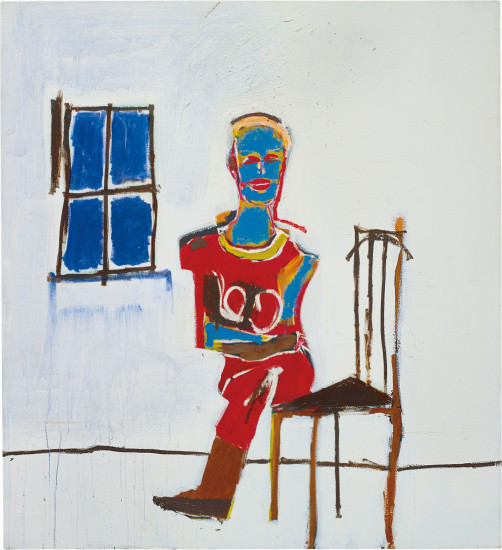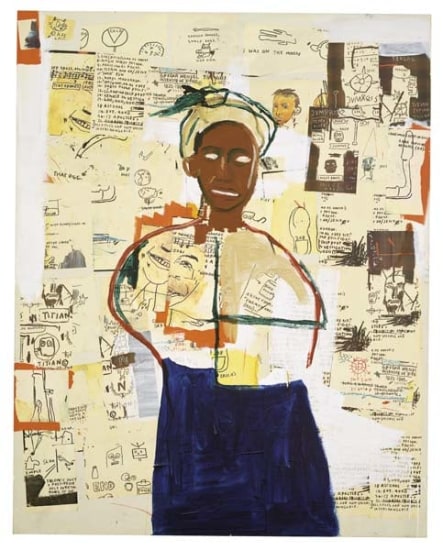Jean-Michel-Basquiat Self-Portrait 1985 acrylic, oil stick, crown cork and bottle caps on wood 55 7/8 x 60 1/4 x 5 7/8 in. (141.9 x 153 x 14.9 cm.) Signed and dated "1985" on the reverse.
Provenance Private Collection, New York Phillips de Pury & Luxembourg, New York, Contemporary Art Part I, November 13, 2003, lot 36 Collection of Jan Krugier Phillips de Pury & Company, London, Contemporary Art Evening Sale, June 27, 2011, lot 8 Acquired at the above sale by the present owner Exhibited Valencia, Instituto Valenciano de Arte Moderno, Fire Under the Ashes (from Picasso to Basquiat),May 5 – August 28, 2005, then traveled to Paris, Musée Maillol-Fondation Dina Vierny (October 8, 2005 – February 14, 2006) Literature E. Navarra, Jean-Michel-Basquiat, Paris: Galerie Enrico Navarra, 2000, vol. II, no. 10, p. 230 (illustrated) Catalogue Essay "I don't think about art when I'm working. I try to think about life." - Jean-Michel-Basquiat, 1999 For the turbulent eight years of his professional career, Jean-Michel-Basquiat was engaged in a constant battle between his private and public artistic identity. While titanically gifted, he felt himself being torn between several realms of expectation, among them that of his dealers, his professional colleagues and most prominently, himself. 1985 saw Basquiat’s height of popularity during his lifetime, with his face adorning the cover of Time magazine and his unquestioned preeminence among les enfants terribles. Yet the year was a turning point for Basquiat as a painter, and his use of diptychs in particular began to adopt more adventurous methods of construction. In keeping with his evolving public and private personality during this time period, the present lot, Self-Portrait, 1985, bears a wealth of three-dimensional beauty that signals a new direction for Basquiat’s exploration of the self. While Basquiat’s career of the early 1980s was filled with overwhelming universal acclaim, it owed most of its success to Basquiat’s revolutionary introduction of numerous forms and tropes previously unseen in contemporary art. Firstly, as he possessed a marvelously diverse cultural heritage of both Puerto Rican and Haitian descent, Basquiat’s incorporations of his ethnic lineage into his work brought about a craze of neo-primitivism not seen since the days of Pablo Picasso’s mask work. Motifs—namely the skull, the anatomized body, and the crown—highlighted Basquiat’s combination of religious influences, primarily Catholicism and Vodou. Yet his provocative titles and figures gave birth to a fascinating renaissance of the examination of black identity as well. His characters, self-portraits or not, often bore chains or signs of racial subjugation, making him the most prominent black painter that the contemporary art world had ever witnessed. Of course, these elements were suffused with Basquiat’s own compositional technique, developed from his early work with punk and graffiti artists. SAMO, his graffiti partnership with Al Diaz, was among the most famous New York City street art of the late 1970s, its spare signage and wordplay assuming the power of ancient hieroglyphs for a modern world. Combined with his fortune of heritage, Basquiat’s scrawled heads and electric color brought the art world so quickly to its knees that the only art historical term that it could come up with to describe him was “neo-expressionist”. This was the defining aspect of Basquiat’s early years, a tsunami of work met with critical wonder—a perfect encapsulation of youthful expression: “Jean-Michel Basquiat was an articulate and prolific spokesman for youth: insatiably curious, tirelessly inventive, innocently self-deprecating because of youth's inadequacies, jealously guarding his independence, typically disappointed by the inherited world he defensively mocked, yet filled with adulation for his heroes. " (M. Mayer, "Basquiat in History," Basquiat, Brooklyn Museum of Art, 2005, p. 46). But as he reached artistic maturity, Basquiat began to branch out into more specialized forms. No longer was the art of 1985 filled with a pastiche of exuberance and anger executed with fabulous abandon; it was sublimely conscious of
Jean-Michel-Basquiat Self-Portrait 1985 acrylic, oil stick, crown cork and bottle caps on wood 55 7/8 x 60 1/4 x 5 7/8 in. (141.9 x 153 x 14.9 cm.) Signed and dated "1985" on the reverse.
Provenance Private Collection, New York Phillips de Pury & Luxembourg, New York, Contemporary Art Part I, November 13, 2003, lot 36 Collection of Jan Krugier Phillips de Pury & Company, London, Contemporary Art Evening Sale, June 27, 2011, lot 8 Acquired at the above sale by the present owner Exhibited Valencia, Instituto Valenciano de Arte Moderno, Fire Under the Ashes (from Picasso to Basquiat),May 5 – August 28, 2005, then traveled to Paris, Musée Maillol-Fondation Dina Vierny (October 8, 2005 – February 14, 2006) Literature E. Navarra, Jean-Michel-Basquiat, Paris: Galerie Enrico Navarra, 2000, vol. II, no. 10, p. 230 (illustrated) Catalogue Essay "I don't think about art when I'm working. I try to think about life." - Jean-Michel-Basquiat, 1999 For the turbulent eight years of his professional career, Jean-Michel-Basquiat was engaged in a constant battle between his private and public artistic identity. While titanically gifted, he felt himself being torn between several realms of expectation, among them that of his dealers, his professional colleagues and most prominently, himself. 1985 saw Basquiat’s height of popularity during his lifetime, with his face adorning the cover of Time magazine and his unquestioned preeminence among les enfants terribles. Yet the year was a turning point for Basquiat as a painter, and his use of diptychs in particular began to adopt more adventurous methods of construction. In keeping with his evolving public and private personality during this time period, the present lot, Self-Portrait, 1985, bears a wealth of three-dimensional beauty that signals a new direction for Basquiat’s exploration of the self. While Basquiat’s career of the early 1980s was filled with overwhelming universal acclaim, it owed most of its success to Basquiat’s revolutionary introduction of numerous forms and tropes previously unseen in contemporary art. Firstly, as he possessed a marvelously diverse cultural heritage of both Puerto Rican and Haitian descent, Basquiat’s incorporations of his ethnic lineage into his work brought about a craze of neo-primitivism not seen since the days of Pablo Picasso’s mask work. Motifs—namely the skull, the anatomized body, and the crown—highlighted Basquiat’s combination of religious influences, primarily Catholicism and Vodou. Yet his provocative titles and figures gave birth to a fascinating renaissance of the examination of black identity as well. His characters, self-portraits or not, often bore chains or signs of racial subjugation, making him the most prominent black painter that the contemporary art world had ever witnessed. Of course, these elements were suffused with Basquiat’s own compositional technique, developed from his early work with punk and graffiti artists. SAMO, his graffiti partnership with Al Diaz, was among the most famous New York City street art of the late 1970s, its spare signage and wordplay assuming the power of ancient hieroglyphs for a modern world. Combined with his fortune of heritage, Basquiat’s scrawled heads and electric color brought the art world so quickly to its knees that the only art historical term that it could come up with to describe him was “neo-expressionist”. This was the defining aspect of Basquiat’s early years, a tsunami of work met with critical wonder—a perfect encapsulation of youthful expression: “Jean-Michel Basquiat was an articulate and prolific spokesman for youth: insatiably curious, tirelessly inventive, innocently self-deprecating because of youth's inadequacies, jealously guarding his independence, typically disappointed by the inherited world he defensively mocked, yet filled with adulation for his heroes. " (M. Mayer, "Basquiat in History," Basquiat, Brooklyn Museum of Art, 2005, p. 46). But as he reached artistic maturity, Basquiat began to branch out into more specialized forms. No longer was the art of 1985 filled with a pastiche of exuberance and anger executed with fabulous abandon; it was sublimely conscious of

.jpg)









Testen Sie LotSearch und seine Premium-Features 7 Tage - ohne Kosten!
Lassen Sie sich automatisch über neue Objekte in kommenden Auktionen benachrichtigen.
Suchauftrag anlegen